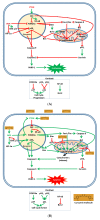Curcumin's Beneficial Effects on Neuroblastoma: Mechanisms, Challenges, and Potential Solutions
- PMID: 33105719
- PMCID: PMC7690450
- DOI: 10.3390/biom10111469
Curcumin's Beneficial Effects on Neuroblastoma: Mechanisms, Challenges, and Potential Solutions
Abstract
Curcumin, a natural polyphenolic compound derived from the South Asian turmeric plant (Curcuma longa), has well-characterized antioxidant, anti-inflammatory, anti-protein-aggregate, and anticancer properties. Neuroblastoma (NB) is a cancer of the nervous system that arises primarily in pediatric patients. In order to reduce the multiple disadvantages and side effects of conventional oncologic modalities and to potentially overcome cancer drug resistance, natural substances such as curcumin are examined as complementary and supportive therapies against NB. In NB cell lines, curcumin by itself promotes apoptosis and cell cycle arrest through the suppression of serine-threonine kinase Akt and nuclear factor kappa of activated B-cells (NF-κB) signaling, induction of mitochondrial dysfunction, and upregulation of p53 and caspase signaling. While curcumin demonstrates anti-NB efficacy in vitro, cross-validation between NB cell types is currently lacking for many of its specific mechanistic activities. Furthermore, curcumin's low bioavailability by oral administration, poor absorption, and relative insolubility in water pose challenges to its clinical introduction. Numerous curcumin formulations, including nanoparticles, nanocarriers, and microemulsions, have been developed, with these having some success in the treatment of NB. In the future, standardization and further basic and preclinical trials will be required to ensure the safety of curcumin formulations. While the administration of curcumin is clinically safe even at high doses, clinical trials are necessary to substantiate the practical efficacy of curcumin in the prevention and treatment of NB.
Keywords: apoptosis; cancer prevention; curcumin; natural substances; neuroblastoma; oncology.
Conflict of interest statement
The authors declare no conflict of interest.
Figures



Similar articles
-
Curcumin as a functional food-derived factor: degradation products, metabolites, bioactivity, and future perspectives.Food Funct. 2018 Feb 21;9(2):705-714. doi: 10.1039/c7fo01242j. Food Funct. 2018. PMID: 29206254 Review.
-
Identification of a novel compound (β-sesquiphellandrene) from turmeric (Curcuma longa) with anticancer potential: comparison with curcumin.Invest New Drugs. 2015 Dec;33(6):1175-86. doi: 10.1007/s10637-015-0296-5. Epub 2015 Nov 2. Invest New Drugs. 2015. PMID: 26521943
-
The use of curcumin as an effective adjuvant to cancer therapy: A short review.Biotechnol Appl Biochem. 2020 Mar;67(2):171-179. doi: 10.1002/bab.1836. Epub 2019 Nov 3. Biotechnol Appl Biochem. 2020. PMID: 31608504 Review.
-
Curcumin: New Insights into an Ancient Ingredient against Cancer.Int J Mol Sci. 2019 Apr 12;20(8):1808. doi: 10.3390/ijms20081808. Int J Mol Sci. 2019. PMID: 31013694 Free PMC article. Review.
-
Curcumin in combined cancer therapy.Curr Pharm Des. 2014;20(42):6682-96. doi: 10.2174/1381612820666140826154601. Curr Pharm Des. 2014. PMID: 25341940 Review.
Cited by
-
Recent Advances in Understanding the Pathogenesis of Rheumatoid Arthritis: New Treatment Strategies.Cells. 2021 Nov 4;10(11):3017. doi: 10.3390/cells10113017. Cells. 2021. PMID: 34831240 Free PMC article. Review.
-
Pyroptosis in Diabetic Peripheral Neuropathy and its Therapeutic Regulation.J Inflamm Res. 2024 Jun 14;17:3839-3864. doi: 10.2147/JIR.S465203. eCollection 2024. J Inflamm Res. 2024. PMID: 38895141 Free PMC article. Review.
-
Curcumin-Loaded Lipid Nanocarriers: A Targeted Approach for Combating Oxidative Stress in Skin Applications.Pharmaceutics. 2025 Jan 21;17(2):144. doi: 10.3390/pharmaceutics17020144. Pharmaceutics. 2025. PMID: 40006512 Free PMC article.
-
Overcoming temozolomide resistance in glioma: recent advances and mechanistic insights.Acta Neuropathol Commun. 2025 Jun 5;13(1):126. doi: 10.1186/s40478-025-02046-4. Acta Neuropathol Commun. 2025. PMID: 40468460 Free PMC article. Review.
-
Nutraceutical Preventative and Therapeutic Potential in Neuroblastoma: From Pregnancy to Early Childhood.Life (Basel). 2022 Nov 2;12(11):1762. doi: 10.3390/life12111762. Life (Basel). 2022. PMID: 36362917 Free PMC article. Review.
References
-
- Moreno F., Lopez Marti J., Palladino M., Lobos P., Gualtieri A., Cacciavillano W. Childhood Neuroblastoma: Incidence and Survival in Argentina. Report from the National Pediatric Cancer Registry, ROHA Network 2000–2012. Pediatr. Blood Cancer. 2016;63:1362–1367. doi: 10.1002/pbc.25987. - DOI - PubMed
-
- Monclair T., Brodeur G.M., Ambros P.F., Brisse H.J., Cecchetto G., Holmes K., Kaneko M., London W.B., Matthay K.K., Nuchtern J.G., et al. The International Neuroblastoma Risk Group (INRG) staging system: An INRG Task Force report. J. Clin. Oncol. 2009;27:298–303. doi: 10.1200/JCO.2008.16.6876. - DOI - PMC - PubMed
Publication types
MeSH terms
Substances
Grants and funding
LinkOut - more resources
Full Text Sources
Medical
Research Materials
Miscellaneous

